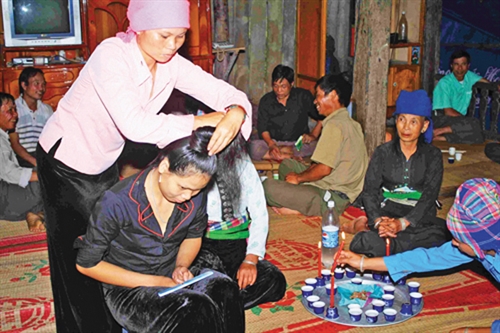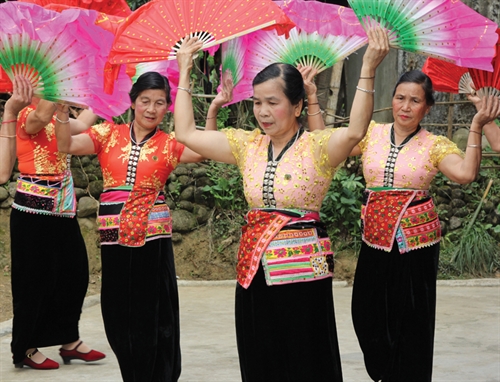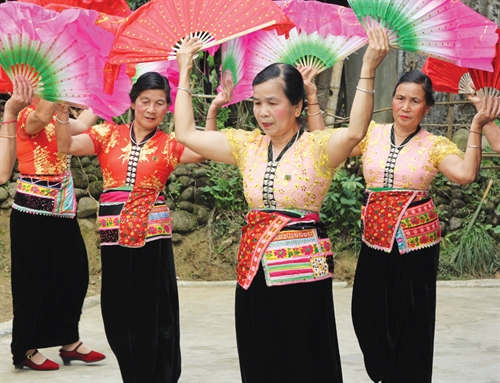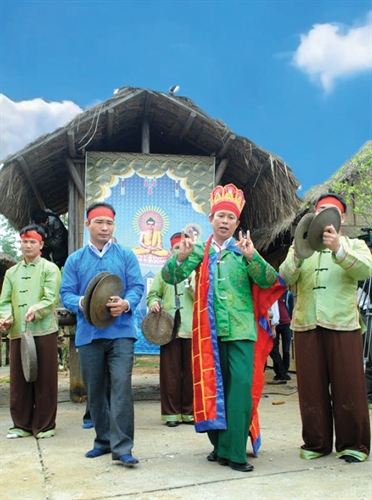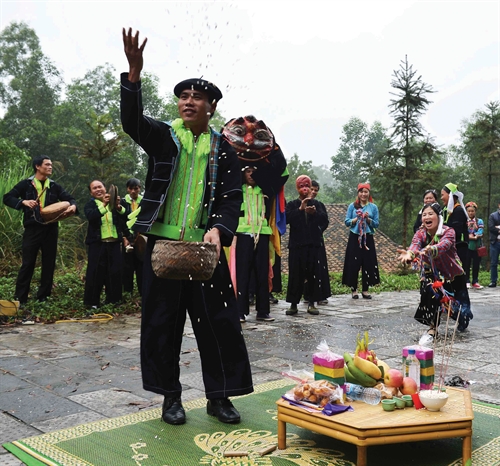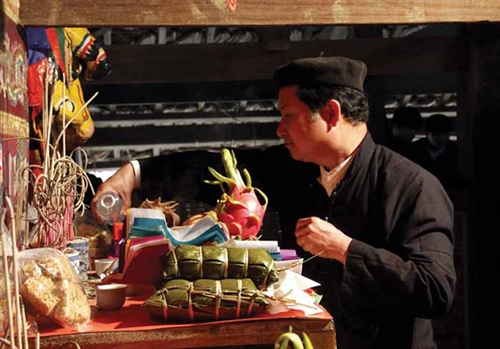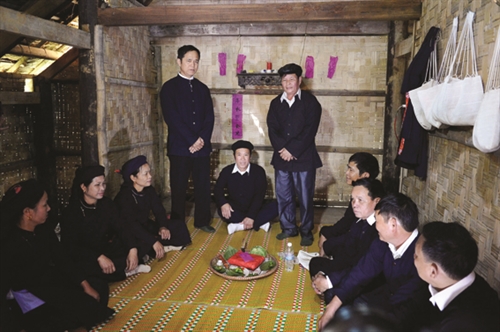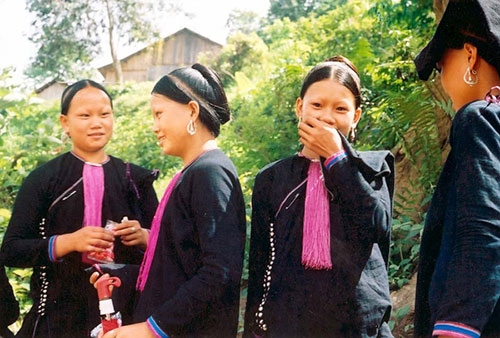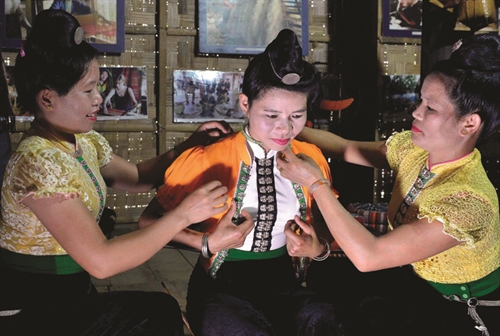>>La Ha ethnicity - its customs, practices and folk laws
Ta Thi Tam
Ethnology Institute
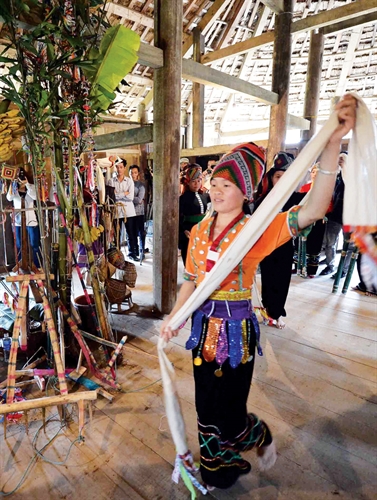 |
| Scarf dancing of the La Ha__Photo: Thanh Ha/VNA |
Mang hoa is an important festival for the La Ha, a Kadai language ethnic group living in the northern mountainous provinces of Lai Chau and Son La.
The ceremony is held every five years at the start of a new crop when bamboo shoots sprout to seek gods’ support for a bumper crop and growing cattle herds.
The ceremony is conducted by the village shaman who is thought to be able to communicate with gods and supernatural powers, acting as a bridge to convey the villagers’ wishes to the gods. As this man is concurrently the herbal therapist of the community, Mang hoa is also a chance for villagers to see him for disease treatment.
The date for holding Mang hoa is chosen by the shaman who then informs it to villagers for preparation.
To make offerings for the ceremony, villagers jointly cook traditional dishes from pigs, chickens, ducks, crabs, fish, chicken eggs, taros, pumpkins, bamboo shoots, bitter liquor, sticky rice, sugarcanes, bananas, banana blossoms and vegetables. Ruou can (rice wine drunk out of a jar through stalks) and banh chung and banh tet (square- and cylinder-shaped sticky rice cake with pork and green bean fillings) are also indispensable.
The La Ha also prepare numerous objects to serve the ceremony, including a sacred flower tree, two lat (phallic symbol), three bunches of flowers which symbolize 36 forest cicadas, bamboo sticks with cloth tassels, a pair of five-color square drums, a pair of green and red round drums, two colorful cloth balls, a fabric scarf, a pair of wooden doves, two pairs of shotguns and swords, a caryota tree which symbolizes a black buffalo, a banana tree which represents a white buffalo, two wooden plows and two wooden harrows.
The sacred flower tree is erected at the shaman’s home before the ceremony starts, consisting of three layers. The highest layer is decorated with two flower branches, three bunches of red silk-cotton blossoms and two yellow paper doves. The middle layer is where the phallic symbols, colorful cloth balls, square and round drums are hung. At the bottom layer, which is the root of the tree, are placed ruou can jars, shotguns and swords. It is also where patients of the shaman place offerings to him.
Mang hoa ceremony is conducted in four officiating rituals. The first is held at the shaman’s ancestor altar without any offerings. At this ritual, the shaman in La Ha traditional costume with an indigo shirt and trousers, a turban and a belt recites prayers to inform his ancestors of the village’s celebration of Mang hoa, invite them to the ceremony and beg their support for him to fulfill his task.
Then comes a ritual to summon the shaman’s spirit, which aims to build the spiritual power for this man to deal with evil spirits throughout the ceremony. Starting the ritual, the shaman puts his shirt, which is the symbolic shelter of his spirit, on a rattan tray placed in the middle part of his house together with a living white rooster, the animal believed to be able to contact the dead and drive away evil spirits. He then sits in front of the rattan tray facing the ancestor altar, praying for gods to give him strength to fight evil spirits during the ceremony.
This ritual is followed by the most important one to invite gods and supernatural powers to the ceremony and seek their protection for villagers, animals and crops. This rite is conducted at the window of spirits in the shaman’s home with a hearty feast of boiled chicken, fish soup, sticky rice and liquor as offerings to gods.
Under the sacred flower tree is also placed another tray of offerings which includes a boiled chicken, grilled fish, sticky rice, boiled pumpkin, forest vegetables, salt mixed with chilly, sugarcanes and bananas. This tray is offered to the village’s tutelary deities, ancestors of families in the village and wandering spirits in a rite officiated by another shaman from the neighboring area, who is invited by the village’s shaman to assist him in Mang hoa.
This ritual, dedicated to gods and supernatural powers, has two formalities: liquor offering to gods and praying for strong spirits of villagers. In the first formality, the shaman with a paper fan in his right hand, recites prayers in a tone which changes constantly from low to high, soft to loud and slow to quick, inviting gods and other supernatural powers to the ceremony and asking for their support for peace and prosperity for villagers. After praying, the shaman opens the jar of ruou can placed under the sacred flower tree, a symbolic act to offer liquor to gods before inviting them to a feast.
After the liquor offering formality, a bunch of bananas, four grilled crabs, two banh tet and a wild animal tusk are additionally put on the offering tray at the window of spirits in preparation for the next formality to pray stronger spirits for villagers to avoid illness and misfortunes.
Each family in the village prepares an offering tray for this formality and places it under the sacred flower tree. The offerings include the head, tail and legs of a pig, boiled bamboo shoots, banh tet, boiled taros, boiled crabs, grilled fish, fish bamboo shoot soup, sticky rice, grilled or boiled chicken, boiled papaya leaves, banana blossoms, sugarcanes, and ruou can.
After all the offerings are arranged neatly, the shaman starts the formality, pleading for supernatural powers to strengthen the spirits of villagers to keep them away from evil spirits. After praying, he practices sorcery using a fire, a knife and the wild animal tusk to evict demons from the village.
The final ritual is dedicated to win the gods’ support for the shaman to build up his spiritual strength to cure his patients. Offerings of this ritual are chickens, doves, fish, bananas, vegetables and bamboo shoots, which are all raised and grown by the shaman’s patients. The offerings are put under the sacred flower tree, showing the patients’ thanks to the shaman as well as their trust in his treatment ability.
The La Ha believe each disease is caused by a particular demon, which can be defeated with the gods’ support and the shaman’s talent.
In this ritual, the shaman prays for gods’ protection and practices magic acts to strengthen his power and purge evil spirits that hang around the village to harm the shaman’s cure.
Then comes the diagnosis stage where the shaman identifies evil spirits that make his patients sick by tasting the food offerings brought by the patients. The shaman can also diagnose diseases by looking at the sick’s shirts. After identifying the evil spirit that causes a disease to a patient, the shaman recites prayers used particularly for treating that disease. He then hangs around the patient’s neck a talisman taken from the sacred flower tree on which magic has been imposed to protect the patient from the evil spirit. The patient is also given a cup of liquor previously offered to gods during the ritual to win the gods’ blessings. The shaman will diagnose and treat the patients one after another following this process.
Apart from the officiating rituals, Mang hoa ceremony is celebrated with folk game playing, and traditional dances and performances in which the shaman often plays the leading role.-
